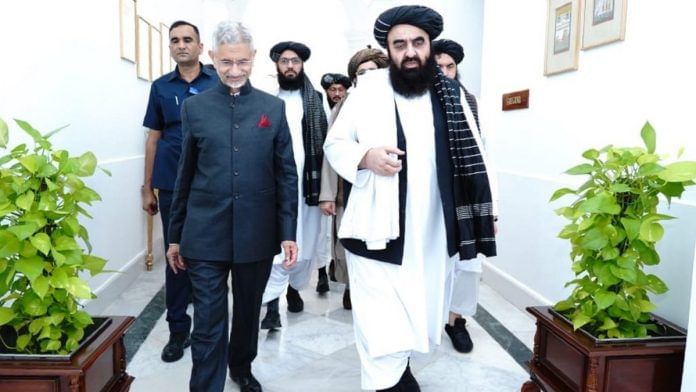Chinese analysts are increasingly framing Pakistan’s ongoing confrontation with Afghanistan not merely as a bilateral conflict but as part of a wider regional dynamic involving India. As one Chinese commentator implied, the real explanation may lie in India’s growing engagement with the Taliban. On Chinese online platforms, much of the discussion links the Taliban administration’s Foreign Minister Amir Khan Muttaqi’s visit to India with the escalation of tensions, with a broad consensus emerging that India plays a role in this evolving situation. This framing reflects a pattern in Chinese strategic discourse, where India’s influence is seen as central to emerging fault lines in the subcontinent.
Wang Shida, a researcher at the China Institutes of Contemporary International Relations and executive director of the Institute of South Asian Studies, argued that Muttaqi’s visit to India marks a gradual build-up of contact and ties between the two sides. He cautioned, however, that this does not mean India will immediately establish formal relations or broad cooperation with Afghanistan; rather, it is a step toward exploring possible areas of collaboration.
That said, the bilateral dimension is receiving limited attention on Chinese online platforms. One Chinese commentator opined that the handshake between Indian External Affairs Minister S Jaishankar and the Afghan Foreign Minister symbolised their shared wariness of Pakistan. The prevailing view online is that India was increasingly concerned about Afghanistan’s growing participation in transnational economic initiatives involving China and Pakistan. Many argue that New Delhi seeks to leverage tensions between Afghanistan and Pakistan to reassert its influence in Kabul; and Afghanistan is visibly choosing India.
Liu Zongyi, a researcher at the Shanghai Institutes for International Studies and director of the Center for South Asia Studies, observed that “the intersection of India’s and the Taliban’s interests lies in Pakistan. Pakistan is caught between India and Afghanistan in the regional geopolitical structure, becoming the ‘sandwich’ between the two forces.”
Another commentator similarly questioned, “Is India really the Taliban’s ‘second choice’? Not necessarily. Relations between the Taliban and India have long been marked by surface politeness and underlying unease. For two decades, India refused to recognise the Taliban regime, opposed its legitimisation at the United Nations, and even suspended aid to Afghanistan when the Taliban returned to power. Now, however, the situation has shifted; India seeks to use the Taliban to counter Pakistan and block the China–Pakistan Economic Corridor’s access to Afghanistan.”
Phoenix TV on Weibo noted that as relations between the Taliban and Pakistan deteriorated, Muttaqi’s visit to India was viewed as a hedging strategy by the Taliban, highlighting a shift toward pragmatism in India’s Afghanistan policy. Another Weibo user wrote that “since January, the Indian diplomatic community has been preparing for engagement with Taliban for months. Jaishankar’s meeting with Muttaqi has set the two countries on a new track of cautious cooperation and redefine the balance of power in South Asia.”
Interestingly, many Chinese internet users are now referring to the Taliban as a terrorist organisation. Yet, such descriptions were conspicuously absent when Chinese Foreign Minister Wang Yi met Taliban representatives and Muttaqi in August and held a tripartite dialogue with Afghanistan and Pakistan in Kabul.
Also read: In Great Game for Kabul, India plays a patient hand. Multi-alignment to compartmentalisation
Taliban, a proxy for India?
Chinese online discussions are also rife with a number of theories. From drone strikes in Kabul to retaliatory shelling along the Durand Line, and the looming presence of India and the US, the conflict is increasingly portrayed not as mere “border friction” but as a manifestation of the subcontinent’s deeper geopolitical contradictions.
A Baijiahao commentator argued that “the Taliban’s actions mark their role in a proxy war. India aims to suppress Pakistan in South Asia but lacks the means to intervene directly. Just days before the border clashes, Afghanistan’s foreign minister visited India and spent six ‘cordial’ days in New Delhi—far longer than protocol demands. Six days isn’t diplomacy; it’s strategy—a stay-at-home order to map out the next decade. And, as expected, the visit ended with a joint statement in which every line struck at Pakistan’s core.”
According to several Chinese commentators, India now seeks to use Afghanistan to contain and fight Pakistan. Adding to the speculation regarding the role of external powers, some claim that the “real-time target intelligence” used in Pakistani airstrikes originates from US satellites. The US, as argued by Zhang Zhixin, a research fellow at the China Institute of Contemporary International Relations’ Institute of American Studies, is attempting to re-establish its foothold in Afghanistan to prevent China and Russia from filling the strategic vacuum.
Beyond their own discussions, Chinese media and online commentators are also amplifying Pakistani narratives. For instance, Observer published an editorial summarising Pakistani media commentary on the India–Afghanistan–Pakistan dynamic. It highlighted concerns that Afghanistan’s rapprochement with India could further destabilise its already fragile relationship with Pakistan, asking whether Kabul “must question if it is becoming a proxy for India.”
The tenor of Chinese commentary suggests that India and the US are viewed as key external actors shaping the conflict, reflecting broader anxieties that the subcontinent’s strategic landscape is once again in flux. Within this narrative, Washington’s potential re-engagement in Afghanistan and New Delhi’s manoeuvring to expand its regional influence are seen as elements of a wider contest for dominance. From the Chinese perspective, India and the US are emerging as the principal disruptors of regional equilibrium, developments perceived as detrimental to China’s strategic and economic interests in the Indian subcontinent.
Sana Hashmi is a fellow at the Taiwan-Asia Exchange Foundation. She tweets @sanahashmi1. Views are personal.
(Edited by Aamaan Alam Khan)






